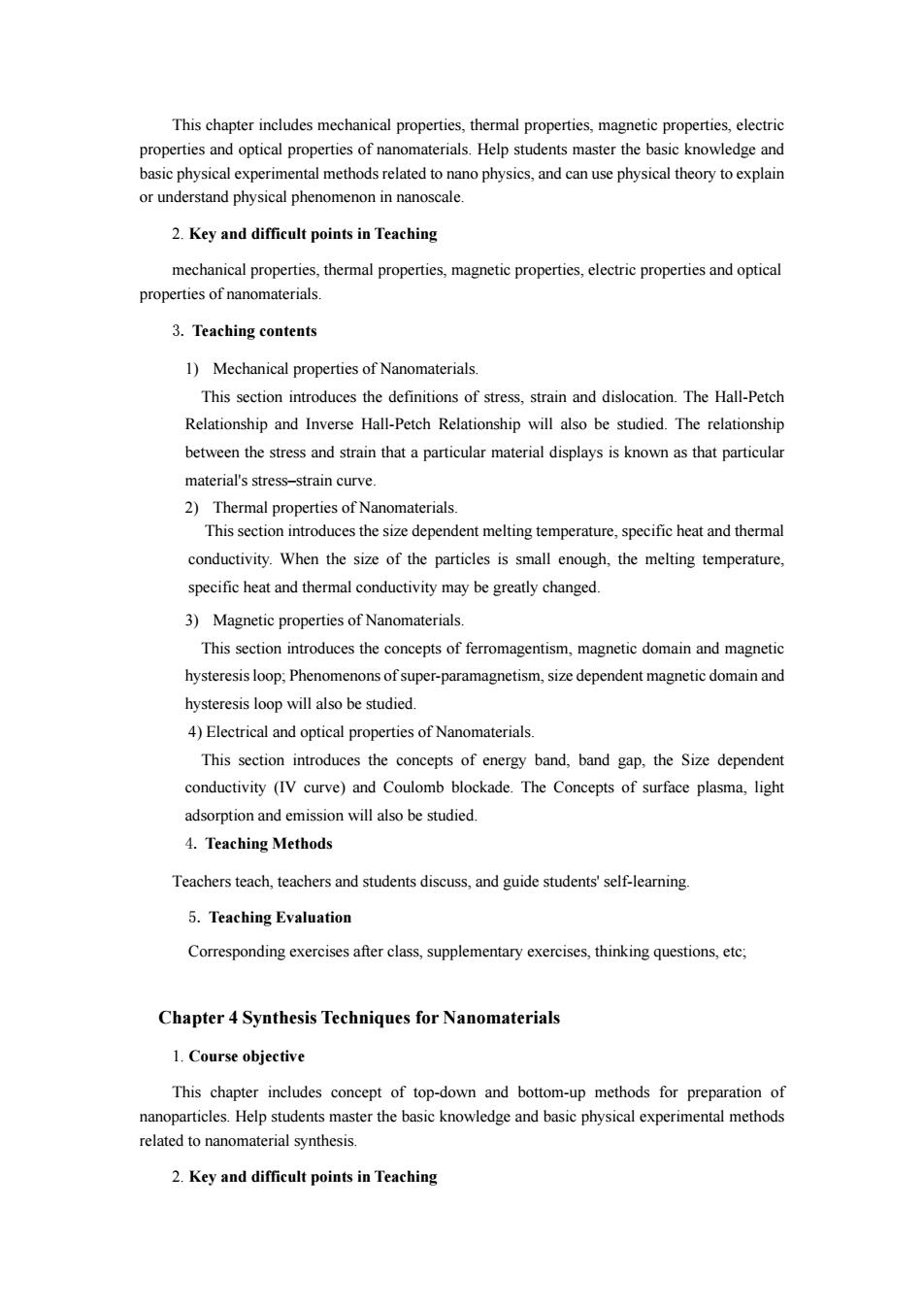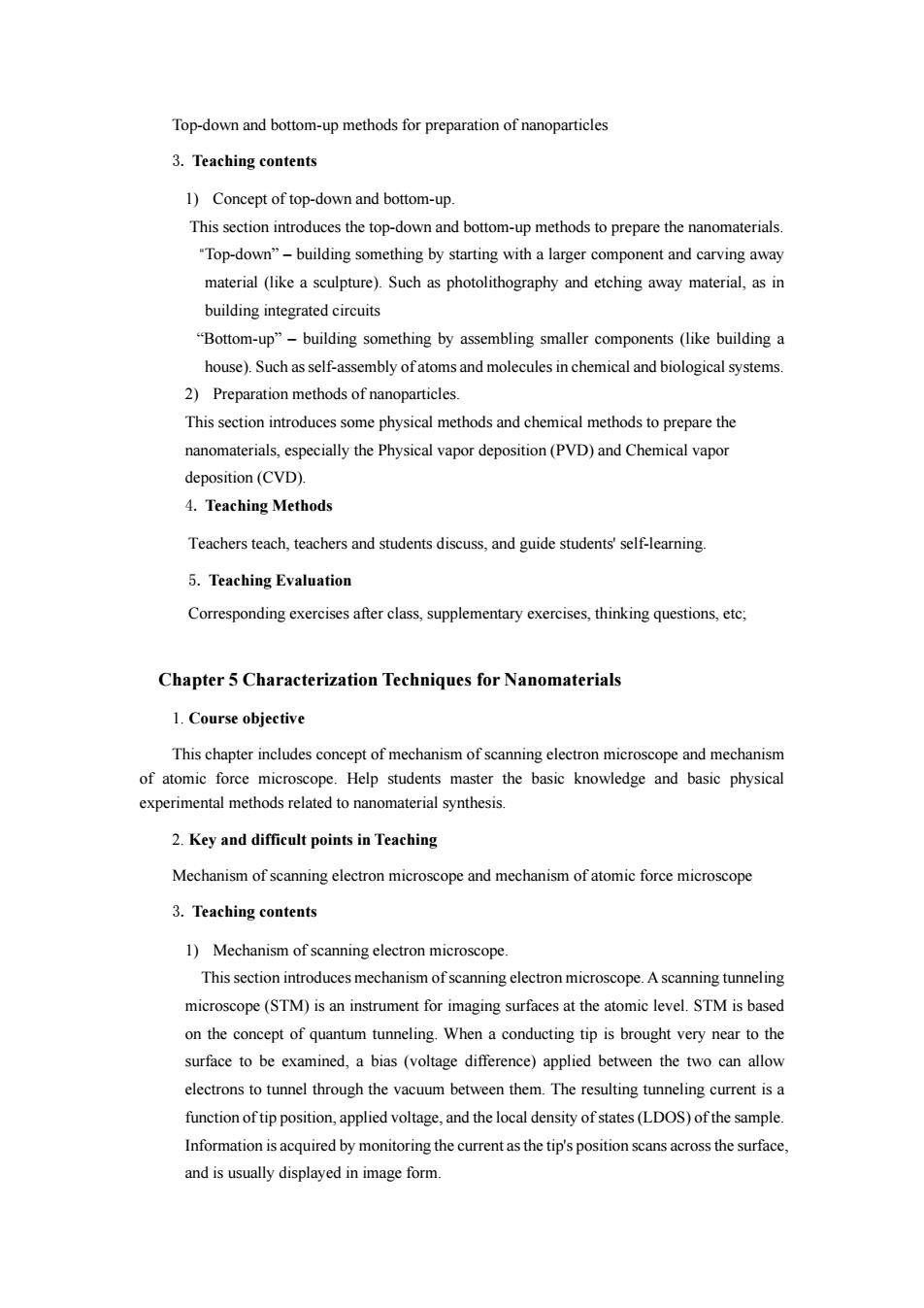
This chapter includes mechanical properties,thermal properties,magnetic properties,electric materials.Help students master the basic knowledge and or understand physical phenomenon in nanoscale 2.Key and difficult points in Teaching mechanical properties,thermal properties,magnetic properties,electric properties and optical properties of nanc naterials 3.Teaching contents 1)Mechanical properties of Nanomaterials. This section introduces the definitions of stress,strain and dislocation.The Hall-Petch Relationship and Inverse Hall-Petch Relationship will also be studied.The relationship between the stress and strain that a particular material displays is known as that particular material's stress-strain curve 2)Thermal properties of Nanomaterials This section introduces the size dependent melting temperature,specific heat and thermal conductivity.When the size of the particles is small enough,the melting temperature specific heat and thermal conductivity may be greatly changed. 3)Magnetic properties of Nanomaterials. This section introduces the concepts of ferromagentism,magnetic domain and magnetic hysteresis loop:Phenomenons of super-paramagnetism,size dependent magnetic domain and hysteresis loop will also be studied. 4)Electrical and optical properties of Nanomaterials. This section inroduces the concepts of energy band,band gap,the Size dependen conductivity (IV curve)and Coulomb blockade.The Concepts of surface plasma,light adsorption and emission will asbe studied. 4.Teaching Methods Teachers teach,teachers and students discuss,and guide studentssef-eain 5.Teaching Evaluation Corresponding exercises after class,supplementary exercises,thinking questions,et Chapter 4 Synthesis Techniques for Nanomaterials 1.Course objective This chapter includes concept of top-dowr and botto om-up methods for preparation of nanoparticles.Help students master the basic knowledge and basic physical experimental methods related to nanomaterial synthesis 2.Key and difficult points in Teaching
This chapter includes mechanical properties, thermal properties, magnetic properties, electric properties and optical properties of nanomaterials. Help students master the basic knowledge and basic physical experimental methods related to nano physics, and can use physical theory to explain or understand physical phenomenon in nanoscale. 2. Key and difficult points in Teaching mechanical properties, thermal properties, magnetic properties, electric properties and optical properties of nanomaterials. 3. Teaching contents 1) Mechanical properties of Nanomaterials. This section introduces the definitions of stress, strain and dislocation. The Hall-Petch Relationship and Inverse Hall-Petch Relationship will also be studied. The relationship between the stress and strain that a particular material displays is known as that particular material's stress–strain curve. 2) Thermal properties of Nanomaterials. This section introduces the size dependent melting temperature, specific heat and thermal conductivity. When the size of the particles is small enough, the melting temperature, specific heat and thermal conductivity may be greatly changed. 3) Magnetic properties of Nanomaterials. This section introduces the concepts of ferromagentism, magnetic domain and magnetic hysteresis loop; Phenomenons of super-paramagnetism, size dependent magnetic domain and hysteresis loop will also be studied. 4) Electrical and optical properties of Nanomaterials. This section introduces the concepts of energy band, band gap, the Size dependent conductivity (IV curve) and Coulomb blockade. The Concepts of surface plasma, light adsorption and emission will also be studied. 4. Teaching Methods Teachers teach, teachers and students discuss, and guide students' self-learning. 5. Teaching Evaluation Corresponding exercises after class, supplementary exercises, thinking questions, etc; Chapter 4 Synthesis Techniques for Nanomaterials 1. Course objective This chapter includes concept of top-down and bottom-up methods for preparation of nanoparticles. Help students master the basic knowledge and basic physical experimental methods related to nanomaterial synthesis. 2. Key and difficult points in Teaching

Top-down and bottom-up methods for preparation of nanoparticles 3.Teaching contents 1)Concept of top-down and bottom-up. This section introduces the top-down and bottom-up methods toprepare the nanomaterials "Top-down"-building something by starting with a larger component and carving away material (like a sculpture).Such as photolithography and etching away material,as in building integrated circuits "Bottom-up"-building something by assembling smaller components(like building a house).Such as self-assembly of atoms and molecules in chemical and biological systems. 2)Preparation methods of nanoparticles This section introduces some physical methods and chemical methods to prepare the nanomaterials,especilly the Physical vapor deposition(PVD)and Chemical vapor deposition (CVD) 4.Teaching Methods Teachers teach,teachers and students discuss,and guide students'self-learning. 5.Teaching Evaluation Corresponding exercises after class.supplementary exercises,thinking questions.etc. Chapter 5 Characterization Techniques for Nanomaterials 1.Course objective This chapter includes concept of mechanism of scanning electron microscope and mechanism of atomic force microscope.Help students master the basic knowledge and basic physical experimental methods related tonanomaterial synthesis 2.Key and difficult points in Teaching Mechanism of scanning electron microscope and mechanism of atomic force microscope 3.Teaching contents 1)Mechanism of scanning electron microscope. This section introduces mechanism of scanning electron microscope.A scanning tunneling microscope(STM)is an instrument for imaging surfaces at the atomic level.STM is based on the concept of quantum tunneling.When a conducting tip is brought very near to the surface to be examined,a bias (voltage difference)applied between the two can allow electrons to tunnel through the vacuum between them.The resulting tunneling current is a function oftip position,applied voltage,and the local density of states(LDOS)of the sample Information is acquired by monitoring the current as the tip's position scans across the surface. and is usually displayed in image form
Top-down and bottom-up methods for preparation of nanoparticles 3. Teaching contents 1) Concept of top-down and bottom-up. This section introduces the top-down and bottom-up methods to prepare the nanomaterials. “Top-down” – building something by starting with a larger component and carving away material (like a sculpture). Such as photolithography and etching away material, as in building integrated circuits “Bottom-up” – building something by assembling smaller components (like building a house). Such as self-assembly of atoms and molecules in chemical and biological systems. 2) Preparation methods of nanoparticles. This section introduces some physical methods and chemical methods to prepare the nanomaterials, especially the Physical vapor deposition (PVD) and Chemical vapor deposition (CVD). 4. Teaching Methods Teachers teach, teachers and students discuss, and guide students' self-learning. 5. Teaching Evaluation Corresponding exercises after class, supplementary exercises, thinking questions, etc; Chapter 5 Characterization Techniques for Nanomaterials 1. Course objective This chapter includes concept of mechanism of scanning electron microscope and mechanism of atomic force microscope. Help students master the basic knowledge and basic physical experimental methods related to nanomaterial synthesis. 2. Key and difficult points in Teaching Mechanism of scanning electron microscope and mechanism of atomic force microscope 3. Teaching contents 1) Mechanism of scanning electron microscope. This section introduces mechanism of scanning electron microscope. A scanning tunneling microscope (STM) is an instrument for imaging surfaces at the atomic level. STM is based on the concept of quantum tunneling. When a conducting tip is brought very near to the surface to be examined, a bias (voltage difference) applied between the two can allow electrons to tunnel through the vacuum between them. The resulting tunneling current is a function of tip position, applied voltage, and the local density of states (LDOS) of the sample. Information is acquired by monitoring the current as the tip's position scans across the surface, and is usually displayed in image form